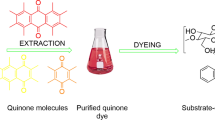Abstract
Verdigris is a green copper organometallic pigment, widely used in paintings during the fifteenth and sixteenth centuries. With ageing, chromatic modifications like browning or darkening can be observed on those green painted layers. An original but crucial approach has been developed based on the characterization of a reference neutral verdigris pigment—anhydrous copper acetate—and model samples, made of verdigris and linseed oil. Samples have undergone artificial ageing (temperature, light) to reproduce the color change effect. They were analysed before and after accelerated ageing tests by a complementary set of classical techniques: colorimetry, electron paramagnetic resonance, X-ray absorption spectroscopy, and UV–visible absorption. Our experiments revealed that the incorporation of the verdigris pigment in linseed oil induces a transformation of the copper acetate bimetallic structure, with the formation of monomeric species. These monomers, however, are not directly responsible for the darkening. The chromatic alteration seems instead linked to the transient formation of Cu(I) in the copper complexes of the pigment/oil system. This formation could be initiated by ambient light absorption through ligand-to-metal charge transfer, which favors the decarboxylation of the copper complexes leading to the reduction of Cu(II) into Cu(I). Moreover, dioxygen can react with partially decarboxylated dimers to form peroxy-Cu dimer complexes that can be responsible for the darkening.








Similar content being viewed by others
References
M. San Andrés, J.M. De la Roja, V.G. Baonza, N. Sancho, J. Raman Spectrosc. 41, 1468 (2010)
H. Kühn, Stud. Conserv. 15, 12 (1970)
C. Cennini, The Craftsman’s Handbook, »Il libro dell’Arte», Translated by Daniel V. Thompson Jr. (Dover, New York, 1954)
L. Da Vinci, Trattato della Pittura (c. 1550), vol. 2, no 214. Translated by McMahon (1956)
R. Wouhuysen-Keller, Hist. Paint. Tech. Mater. Studio Pract. 26–29, 65–69 (1995)
M. Gunn, G. Chottard, E. Rivière, J.-J. Girerd, J.-C. Chottard, Stud. Conserv. 47(1), 12 (2002)
L. Cartechini, C. Miliani, B.G. Brunetti, A. Sgamellotti, C. Altavilla, E. Ciliberto, F. D’Acapito, Appl. Phys. A 92(1), 243 (2008)
E. Ioakimoglou, S. Boyatzis, P. Argitis, A. Fostiridou, K. Papapanagiotou, N. Yannovits, Chem. Mater. 11(8), 2013 (1999)
S. Boyatzis, E. Ioakimoglou, P. Argitis, J. Appl. Polym. Sci. 84(5), 936 (2002)
C. Altavilla, E. Ciliberto, Appl. Phys. A 83(4), 699 (2006)
D.A. Scott, Copper and Bronze in Art: Corrosion, Colorants, Conservation, vol. 270 (Getty Publications, 2002)
M. VanEikema-Hommes, Discoloration in Renaissance and Baroque Oil Paintings, Thesis, Amsterdam, University, under the direction of Van de Wetering E. (2002)
B. Ravel, M. Newville, J. Synchrotron Rad. 12, 537 (2005)
J. Svorec, M. Valko, J. Moncol, M. Mazúr, M. Melník, J. Telser, Transit. Met. Chem. 34(2), 129 (2009)
M.V. Fedin, Dalton Trans. 42, 4513 (2013)
C.D. Delfs, R. Bramley, Chem. Phys. Lett. 264, 333 (1997)
P. Sharrock, M. Melnik, Can. J. Chem. 63(1), 52 (1985)
H. Grasdalen, J. Magn. Reson. 9(1), 166 (1973)
L.S. Kau, D.J. Spira-Solomon, J.E. Penner-Hahn, K.O. Hodgson, E.I. Solomon, J. Am. Chem. Soc. 109(21), 6433 (1987)
J.L. DuBois, P. Mukherjee, T.D.P. Stack, B. Hedman, E.I. Solomon, K.O. Hodgson, J. Am. Chem. Soc. 122(24), 5775 (2000)
T.A. Smith, J.E. Penner-Hahn, M.A. Berding, S. Doniach, K.O. Hodgson, J. Am. Chem. Soc. 107(21), 5945 (1985)
F. Tuczek, E.I. Solomon, Coord. Chem. Rev. 219–221, 1075 (2001)
P.K. Ross, M.D. Allendorf, E.I. Solomon, J. Am. Chem. Soc. 111(11), 4009 (1989)
P. Ciésla, P. Kocot, P. Mytych, Z. Stasicka, J. Mol. Catal. A Chem. 224, 17 (2004)
E.I. Solomon, F. Tuczek, D.E. Root, C.A. Brown, Chem. Rev. 94(3), 827 (1994)
Acknowledgments
This work was supported by the Patrima LabEx and the Foundation for Cultural Heritage Sciences.
Author information
Authors and Affiliations
Corresponding author
Rights and permissions
About this article
Cite this article
Santoro, C., Zarkout, K., Le Hô, AS. et al. New highlights on degradation process of verdigris from easel paintings. Appl. Phys. A 114, 637–645 (2014). https://doi.org/10.1007/s00339-014-8253-2
Received:
Accepted:
Published:
Issue Date:
DOI: https://doi.org/10.1007/s00339-014-8253-2




